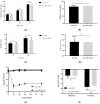Putative Role of an ABC Efflux System in Aliarcobacter butzleri Resistance and Virulence
- PMID: 36830250
- PMCID: PMC9951867
- DOI: 10.3390/antibiotics12020339
Putative Role of an ABC Efflux System in Aliarcobacter butzleri Resistance and Virulence
Abstract
Aliarcobacter butzleri is considered a ubiquitous microorganism and emergent pathogen, for which increasing rates of multidrug resistance have been described. In line with this, the present work aimed to evaluate for the first time the contribution of an ABC efflux system, the YbhFSR, in the resistance and virulence of this bacterium. Following the in silico characterization of the YbhFSR transporter, a mutant strain was constructed by inactivating the gene responsible for ATP-binding. After ensuring that the mutation did not have an impact on bacterial growth, the resistance profile of parental and mutant strains to different antimicrobial agents was evaluated. The results suggest that the efflux pump may influence the resistance to benzalkonium chloride, ethidium bromide, and cadmium, and several other compounds were identified as potential substrates. Regarding the evaluation of the accumulation of ethidium bromide, a slight increase was observed for the mutant strain, demonstrating a potential role of the YbhFSR efflux pump in the extrusion of toxic compounds from A. butzleri. Subsequently, the role of this efflux pump on the A. butzleri known virulence properties was evaluated, but no difference was seen among mutant and parental strains for the motility, biofilm formation ability, susceptibility to oxidative stress, or the ability to adhere and invade Caco-2 cells. However, in contrast to the parental strain, the mutant strain showed a resistance to human serum. Overall, the results support the role of efflux pumps in A. butzleri resistance to antimicrobials, highlighting the particular role of the YbhFSR system.
Keywords: ABC efflux pumps; Aliarcobacter butzleri; YbhFSR; resistance; virulence.
Conflict of interest statement
The authors declare no conflict of interest.
Figures



Similar articles
-
RND Efflux Systems Contribute to Resistance and Virulence of Aliarcobacter butzleri.Antibiotics (Basel). 2021 Jul 6;10(7):823. doi: 10.3390/antibiotics10070823. Antibiotics (Basel). 2021. PMID: 34356744 Free PMC article.
-
Characterization of AreABC, an RND-Type Efflux System Involved in Antimicrobial Resistance of Aliarcobacter butzleri.Antimicrob Agents Chemother. 2021 Aug 17;65(9):e0072921. doi: 10.1128/AAC.00729-21. Epub 2021 Aug 17. Antimicrob Agents Chemother. 2021. PMID: 34152822 Free PMC article.
-
A Putative Efflux Transporter of the ABC Family, YbhFSR, in Escherichia coli Functions in Tetracycline Efflux and Na+(Li+)/H+ Transport.Front Microbiol. 2020 Apr 23;11:556. doi: 10.3389/fmicb.2020.00556. eCollection 2020. Front Microbiol. 2020. PMID: 32390957 Free PMC article.
-
[The importance of efflux systems in antibiotic resistance and efflux pump inhibitors in the management of resistance].Mikrobiyol Bul. 2015 Apr;49(2):278-91. doi: 10.5578/mb.8964. Mikrobiyol Bul. 2015. PMID: 26167829 Review. Turkish.
-
Bacterial Multidrug Efflux Pumps at the Frontline of Antimicrobial Resistance: An Overview.Antibiotics (Basel). 2022 Apr 13;11(4):520. doi: 10.3390/antibiotics11040520. Antibiotics (Basel). 2022. PMID: 35453271 Free PMC article. Review.
Cited by
-
First report of Aliarcobacter cryaerophilus in ready-to-cook chicken meat samples from super shops in Bangladesh.J Adv Vet Anim Res. 2023 Mar 31;10(1):113-117. doi: 10.5455/javar.2023.j659. eCollection 2023 Mar. J Adv Vet Anim Res. 2023. PMID: 37155535 Free PMC article.
-
Widespread Multidrug Resistance of Arcobacter butzleri Isolated from Clinical and Food Sources in Central Italy.Antibiotics (Basel). 2023 Aug 5;12(8):1292. doi: 10.3390/antibiotics12081292. Antibiotics (Basel). 2023. PMID: 37627712 Free PMC article.
References
-
- Waite D.W., Vanwonterghem I., Rinke C., Parks D.H., Zhang Y., Takai K., Sievert S.M., Simon J., Campbell B.J., Hanson T.E., et al. Comparative Genomic Analysis of the Class Epsilonproteobacteria and Proposed Reclassification to Epsilonbacteraeota (phyl. nov.) Front. Microbiol. 2017;8:682. doi: 10.3389/fmicb.2017.00682. - DOI - PMC - PubMed
-
- Ramees T.P., Dhama K., Karthik K., Rathore R.S., Kumar A., Saminathan M., Tiwari R., Malik Y.S., Singh R.K. Arcobacter: An Emerging Food-Borne Zoonotic Pathogen, Its Public Health Concerns and Advances in Diagnosis and Control—A Comprehensive Review. Vet. Q. 2017;37:136–161. doi: 10.1080/01652176.2017.1323355. - DOI - PubMed
Grants and funding
LinkOut - more resources
Full Text Sources

